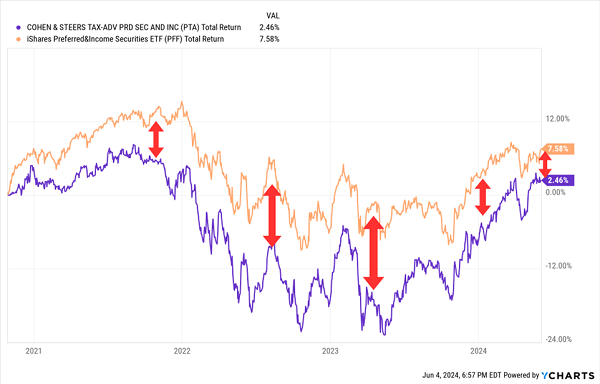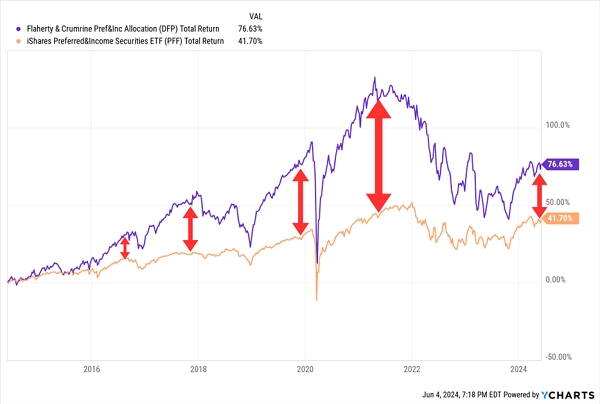Is there anything better than a true bond bargain? I mean, feed me those monthly dividends with a side of price upside and I’ll never ask for anything more!
Gains from a bond fund? Yes, we contrarian income investors want it all. And we can have it when we buy funds yielding up to 9.4% at discounts up to 12%.
Mr. and Ms. Market are finally realizing that rates did not eclipse their 2023 highs. In fact, they appear to be putting in a lower high, which would be quite bullish for the bonds that Wall Street has been ironically panning all year:
Reality Check: Rates Still Lower Than Last Year

And what’s good for bonds is also good for one of my favorite income investments: the preferred stock.
Preferred stocks are so-called “hybrid” investments. They’re part-stock, but also part-bond. For instance, we buy preferreds on a stock exchange (like common stocks), and they represent ownership in a company (like common stocks). But their dividends are usually fixed (like bonds), they’re extremely sensitive to interest rates (like bonds), and their price action is closer to bonds.
In other words: When bonds finally take off, preferred stocks will join them—so if we can get them at a discount (and we can), we should try to lock in their uncommonly high dividends while we can.
But let’s avoid investing in preferreds like the “dumb money.”
Most people offload their preferred portfolios to vanilla ETFs. They’re a cheap way of getting a diversified portfolio of these stocks, sure. But I prefer closed-end funds (CEFs), which can sometimes allow us to buy preferreds at an even bigger discount than if we bought them on their own—and sometimes offer higher collective yields to boot!
Here are three preferred CEFs currently yielding between 7.1% and 9.4% that let us snatch up these preferreds for as little as 88 cents on the dollar.
Cohen & Steers Tax-Advantaged Preferred Securities and Income Fund (PTA)
Distribution Rate: 8.3%
Cohen & Steers Tax-Advantaged Preferred Securities and Income Fund (PTA) is one of the youngest preferred CEFs you’ll come across, coming to life less than four years ago in October 2020.
When we’re dealing with fixed income and hear “tax-advantaged,” our mind immediately goes to municipal bonds. But that’s not what this is. According to Cohen & Steers, PTA is designed to “achieve favorable after-tax returns for its shareholders by seeking to minimize the U.S. federal income tax consequences on income generated by the Fund.” And it does that in two ways:
- Invest in preferreds that pay qualified dividends. This is pretty easily done. After all, many preferreds already pay qualified dividends.
- Achieve favorable tax treatment by holding longer. PTA is being mindful of locking up favorable long-term capital gains rates. But again, that’s an easy ask—preferred funds typically don’t day-trade their holdings.
In other words: PTA’s “special sauce” isn’t all that special.
That’s reflected in an unremarkable portfolio of about 240 preferreds, which are predominantly from financial-sector companies like Wells Fargo (WFC) and Charles Schwab (SCHW). Credit quality is a bit lower than your typical preferred fund, with only about half (51%) of its assets wrapped up in investment-grade holdings. If there’s anything that sticks out, it’s that PTA is more of a global portfolio than explicitly U.S.-based. American preferreds are still in the majority, at 60% of the fund, but that still leaves a much larger-than-average 40% chunk of assets invested in preferreds from Canada, France, the U.K., and other countries.
I’ve evaluated PTA a couple of times in the past, and most recently I pointed out that it has been the runt of the litter since its 2020 inception. But in recent months, it has been closing the gap.
Why Is PTA Catching Up?

I’d credit two factors. One is a narrowing discount to NAV. PTA has traded at a nearly 8% discount over its publicly traded life, but that has slimmed of late, to under 6%. The other is very high debt leverage of 35%—not grand when that leverage amplifies losses and when rising interest rates make that debt more expensive, but much more beneficial during upswings in preferreds and an eventual shift lower in interest rates.
First Trust Intermediate Duration Preferred & Income Fund (FPF)
Distribution Rate: 9.4%
The First Trust Intermediate Duration Preferred & Income Fund (FPF) is a rare preferred fund with a focus on duration. Specifically, FPF aims for a portfolio duration of between three and eight years—currently, it sits on the low end at roughly four years.
Past that, FPF is similar to most preferred funds in that it’s predominantly made up of financial stocks. But like PTA, it’s dissimilar because of its high level of international holdings—FPF’s U.S. preferreds are only slightly more than half (53%) of assets, with Canada, the U.K. and France headlining a robust international lineup.
There’s plenty to like with FPF. A combination of higher-than-average credit quality (~70% investment-grade), modest duration, high yields and high leverage (~33%) has largely allowed this First Trust fund to take more advantage of bull runs in preferreds than plain-vanilla ETFs.
FPF Has Outperformed … Albeit in Fits and Starts

Also, FPF trades at a near-7% discount—not a screaming bargain, per se, but still a decent discount that’s wider than its 5% five-year average.
Flaherty & Crumrine Dynamic Preferred and Income Fund (DFP)
Distribution Rate: 7.1%
Flaherty & Crumrine Dynamic Preferred and Income Fund (DFP) is one of the cheapest preferred CEFs you can find at the moment, with a double-digit discount to NAV of 12% right now.
That’s mighty appealing for a fund that has wiped the floor with basic index ETFs over the longer term.
DFP Struggled the Past Couple Years But Is Regaining Its Mojo

Flaherty & Crumrine’s preferred CEF holds about 220 stocks at the moment. Financials are, as expected, the largest sector by far. DFP does have some international exposure, but at less than 30%, it’s more on par with the category norm. Credit quality isn’t, though—less than half the portfolio is made up of investment-grade securities, so management clearly is OK with taking some level of risk.
And clearly, as the chart above shows, it has worked!
Also, if DFP sounds familiar to some of you, that’s because it was once a Contrarian Income Report holding—it delivered us an average 8% annual gain for seven years, with almost all of that coming via dividend cash. One thing in particular that we liked was the strong insider ownership. Bradford Stone, one of DFP’s managers, holds nearly $500,000 worth in the fund’s shares, demonstrating that his interests are very much aligned with shareholders.
The Bond Bull: 3 Funds Yielding Up to 12% With Massive Upside Potential
The bond market has been pulverized in recent years, with many bonds getting slashed by 50% or more—on par with the Dot-Com Bubble bust and Great Financial Crisis!
But fixed income has recently shown flickers of life—a quick reversal that could signal the start of a new “bond bull.”
And I’m getting ready by positioning myself into three funds that not only deliver fat yields of up to 12%, but have massive upside potential, too.
Bonds are throwing off their highest yields in more than a decade! The “Agg” index, with a yield of around 4.3%, is paying more than 4x what it did just three years ago.
The Fed has signaled multiple rate cuts—and as you know, when rates head lower, bond prices head higher.
So right now, we have a rare chance to lock in uber-high rates before they disappear, and set ourselves up for price upside when bonds pick up steam. It’s a powerful 1-2 punch most investors don’t think about when it comes to the bond market!
I’m not the only one who has noticed, either. Capital Group, Pimco, BlackRock … all of Wall Street’s big names, collectively managing trillions of dollars, are starting to notice the potential for a sea change in the coming months.
If things go the way the Fed, the biggest investment firms and I think—well, astute investors can make a boatload of money in the bond market.
